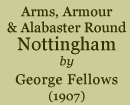< Strelley (contd.) | Contents | Wollaton >
St Mary's and All Saints', Willoughby.
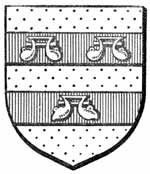 |
ARMS OF WILLOUGHBY—Or, on two bars gules, three water bougets argent. |
THE Nottinghamshire Willoughbys have for several centuries been identified with their fine Elizabethan Hall at Wollaton rather than with the remote little village on the Wolds, situated near to the Roman Fosse Road at the southern extremity of the county, from which they take their patronymic; nevertheless, it is to this Church that the family must refer for the monuments of its earliest representatives, whose effigies form an interesting group in the neglected side Chapel dedicated to St. Nicholas, but called the "Dead House" by the villagers.
The originator of the family was Ralph Bugge, a wealthy merchant of Nottingham, who in the days of King Henry III. seems to have possessed land at Willoughby-on-the-Wolds, which passed to his eldest son, Richard de Wiluby.
The earliest monuments here are two in stone—one a cross-legged Knight in a suit of mail with a surcoat and cingulum and a narrow shield without device, apparently dating from early in the Thirteenth Century; beside him lies his wife.
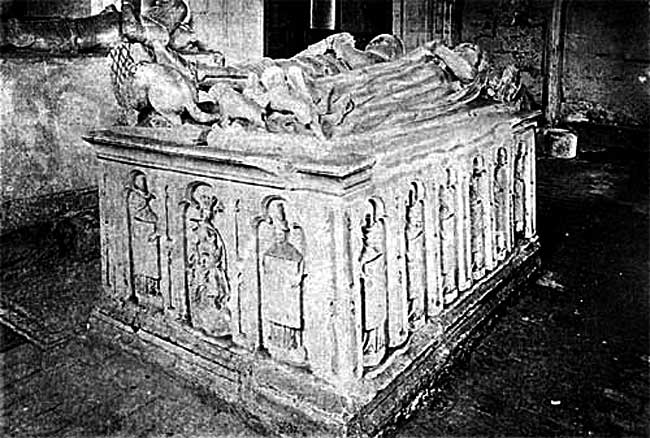 |
Tomb of Sir Hugh de Willoughby (1448). |
The other monument represents two recumbent ladies, each in a devotional attitude. Both these monuments are on the floor, and, although nameless, they are probably connected with the Willoughby family. Alongside the north wall of this Chapel is the alabaster table tomb of Sir Richard Willoughby, great grandson of the said Ralph Bugge. He was an eminent Judge in the days of Edward III. Although he was twice married, and one of his wives was Isabel Mortein, the heiress who brought him the Wollaton and other estates, his effigy alone appears upon the tomb. He is represented in his sumptuous judicial robes, embroidered with the letter b., with wide sleeves displaying the tightly-buttoned robe beneath, and with an anelace at his right side, emblematic of office, not defence. His costume is so well shown in detail by the skilful alabaster carver as to have been considered worthy of an illustration in Stothard's Monumental Effigies and Fairholt's Costume in England.
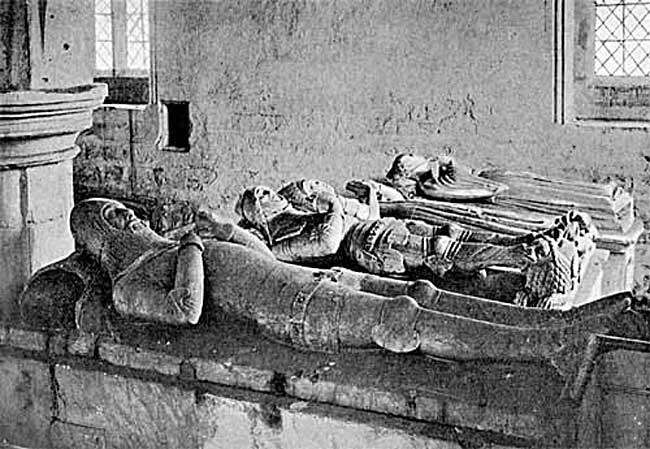 |
The Willoughby effigies, Willoughby-on-the-Wolds. |
The next in order of antiquity is placed under the easternmost arch of the north arcade, and is that of the Judge's son, Richard de Willoughby, who married a sister of Lord Grey. There is no effigy of her, but her arms, viz., Barry of six argent and azure, appear on a shield on one of the panels, and thus, in the absence of any inscription, serve to identify him. He wears the camail, in this instance fastened outside the pointed bascinet; on his jupon may be detected the family arms; he wears a horizontal hip-belt, sollerets, vambraces, and greaves, whilst gussets of mail appear at the armpits and insteps. He died, without issue, about the close of the Fourteenth Century.
The most attractive feature of this group is the double alabaster, once embattled, table tomb that occupies the centre of this side Chapel, on the slab of which lie the effigies of Hugh de Willoughby, miles, and one of his wives, the first of whom was a Foljambe, as stated on a floor-stone, the inscription on which is now illegible, but which has been recorded; it is, however, misleading, as it states the year of her death as being 1317, instead of 1417. His second wife was sister and co-heir of Sir Baldwin Freville, and through her the Middleton estates in Warwickshire came to the family, and from which the first Lord Middleton took the title. The Knight is clad in a suit of richly-chased Gothic armour ; it shows a somewhat late example of a horizontal sword-belt, a skirt of taces with remarkably small tuilles, epaulieres, and genoullieres; his feet in sollerets press against a very long-tailed lion. He is represented as helmed with a salade and high gorget, which protects the lower part of his face, whilst the coutes at the elbow are of the fan-shaped kind; his breastplate has a ridge down the centre, the armpits are guarded by shield-shaped pieces instead of the usual roundels. The lady by his side wears a flowing robe, fastened at the throat with brooches, from which long tassels hang; her horned head-dress, covered with jewelled network, is one of those monstrosities which characterised her period; at her feet lie two ugly dogs. The Altar base is a fine piece of workmanship; angels, holding shields, occupy sixteen panels; the centre panel at the east and west ends contain, in the west end, a representation of the Holy Trinity, very similar in design to one on a brass in Childrey Church, Berks., dated 1480; and in the east end, the Virgin Mother and Child.
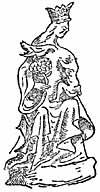
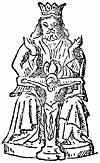
All these tombs have been subjected to rough treatment; most of them bear numerous initials cut upon them by vandal hands, and many are the chippings and cracks; and this is not to be wondered at, for at one time, when a portion of the Church was set apart for the village school, this Chapel was used as the 'punishment corner.' The Chapel has a neglected appearance, and is used to harbour a miscellaneous collection of things, which should not be tolerated within a Church; possibly this may now be different, and it is satisfactory to learn that a much-needed restoration of the fabric is in contemplation.
It may be mentioned that the large meadow adjoining the Church was the scene of a considerable skirmish between the Royalists and Parliamentarians on 5th July, 1648. A brass in the Church floor indicates the resting-place of Colonel Michael Stanhope, of the Royalist force, who was killed in the action.. Also that near the village on the Fosse Road was the Roman Station "Vernometum."
< Strelley (contd.) | Contents | Wollaton >
